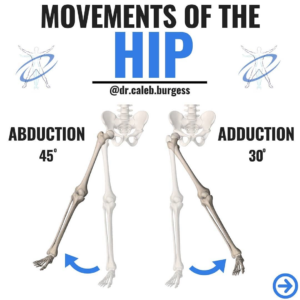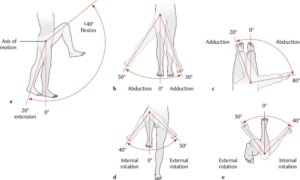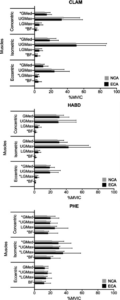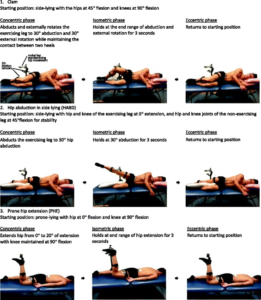HIP AB·DUCTION – SIDE LYING LEG RAISE – RESEARCH
Click on Image to Enlarge
EMG STUDIES
UPPER GLUTEUS MAXIMUS, GLUTEUS MEDIUS, TFL
– Side Lying with Hip Flexed @45º and Knee Flexed @90º
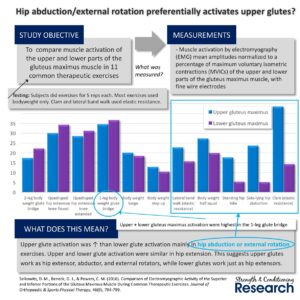 Which Exercises Target the Gluteal Muscles While Minimizing Activation of the Tensor Fascia Lata? – 2013
Which Exercises Target the Gluteal Muscles While Minimizing Activation of the Tensor Fascia Lata? – 2013
Procedure
– determine which exercises are best for activating the gluteus medius and the superior portion of the gluteus maximus, while minimizing activity of the tensor fascia lata (TFL).
Fine Wire Electrodes
– SUP-GMAX: superior and lateral to midpoint of a line drawn b/n the posterior superior iliac spine and posterior greater trochanter.
– GMED: inserted 2.5 cm distal to the midpoint of the iliac crest (ie, middle portion).
– TFL: inserted distal and slightly lateral to the anterior superior iliac spine and medial and superior to the greater trochanter.
| Hip abduction in side lying | Starting position was lying on a treatment table, on the side opposite the tested limb. The table was placed along a wall. The lower extremity on the table was flexed to 45° at the hip and 90° at the knee. The subject’s back and plantar foot were against the wall for control of position and movement. The subject then abducted the tested hip to approximately 30° and then returned the limb to the table. To control for the correct movement, the subject kept the heel in light contact with the wall (via a towel) while sliding it along the wall, with the toes pointed horizontally away from the wall. |
Results
| Exercise | Tensor Fascia Lata | Gluteus Medius | Superior Gluteus Maximus |
|---|---|---|---|
| Side-lying hip abduction | 32.3 ± 13.1 | 43.5 ± 14.7 (P = .012)† | 23.7 ± 15.3 (P = .033)‡ |
| Bilateral bridge – Hip Thrust | 8.2 ± 7.4 | 15.0 ± 10.5 (P = .011)† | 17.4 ± 11.9 (P = .008)† |
| Clam | 11.4 ± 11.4 | 26.7 ± 18.0 (P = .006)† | 43.6 ± 26.1 (P<.001)† |
| Hip hike | 31.4 ± 14.4 | 37.7 ± 15.1 (P = .196) | 17.7 ± 15.2 (P = .001)‡ |
| Lunge | 21.6 ± 14.5 | 19.3 ± 12.9 (P = .623) | 20.1 ± 11.1 (P = .728) |
| Quadruped hip extension, knee extending | 15.6 ± 9.3 | 27.3 ± 14.9 (P<.002)† | 28.5 ± 16.6 (P<.007)† |
| Quadruped hip extension, knee flexed | 18.7 ± 10.6 | 30.9 ± 15.2 (P = .001)† | 30.1 ± 12.5 (P = .012)† |
| Sidestep | 13.1 ± 7.1 | 30.2 ± 15.7 (P = .002)† | 27.4 ± 16.7 (P = .002)† |
| Squat | 4.6 ± 3.8 | 9.7 ± 7.3 (P = .017)† | 12.9 ± 7.9 (P<.001)† |
| Step-up | 21.4 ± 11.4 | 29.5 ± 14.9 (P = .065) | 22.8 ± 15.6 (P = .754) |
| Unilateral bridge – Hip Thrust | 18.1 ± 12.9 | 30.9 ± 20.7 (P = .007)† | 34.6 ± 16.8 (P = .001)† |
GLUTEUS MAXIMUS UPPER & LOWER, GLUTEUS MEDIUS
– Side Lying to 30º with Straight Leg
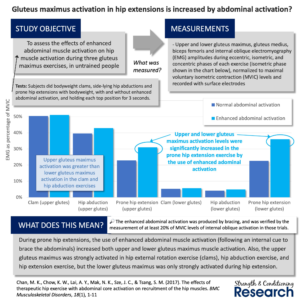 The effects of therapeutic hip exercise with abdominal core activation on recruitment of the hip muscles – 2017 – Chan
The effects of therapeutic hip exercise with abdominal core activation on recruitment of the hip muscles – 2017 – Chan
Procedure
· 2 conditions: Natural Core Activation, Enhanced Core Activation
Results
Clam: hip flexed 45°; knees flexed to 90°; hip abduction 30°; hip external rotation 30°
· upper glute max 40 | glute medius 15 | lower glute max 5
Side-Lying Hip Ab-duction: to 30° with knee fully extended
· upper glute max 30 | glute medius 30 | lower glute max 5
Prone Hip Extension: knee flexed to 90°; hip extension up to 20°
· lower glute max 25 | upper glute max 20 | glute medius 20 | biceps femoris 20
